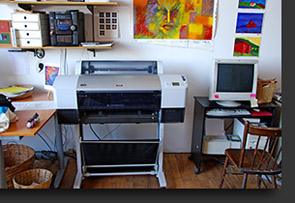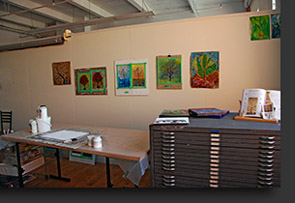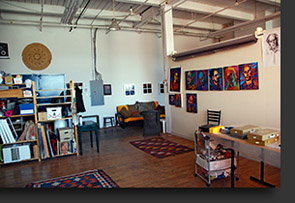Mixed Media Digital Printing
Intro
These days I call myself a mixed media digital artist, though the rapid change of technology and media make these definitions and titles quite fluid. When I started creating art on the computer, I first mixed it with scanned photography and then digital photography. In the last few years I have become increasing interested in mixing my digital work with acrylic paint and textures and then printing on surprising substrates such as metal, canvas and rice paper. I want it all: the physicality and tactile nature of the traditional media and the glorious possibilities that digital media offers!
History
I started learning about the techniques and products used in mixed media digital printing from a variety of sources. In 2004 I bought a wonderful book called Digital Art Studio written by 3 artists , Karin Schminke, Dorothy Simpson Krause and Bonny Pierce Lhotka. Together they began Digital Atelier , a printing making studio where they were instrumental in developing the ideas and techniques of mixing inkjet printing with traditional art materials. In 2007 I went to Booksmart Studio in Buffalo for a weekend workshop with Mary Taylor and learned how to use some of the products and techniques used in mixed media digital printing.
Techniques
Key to the process I use is a particular piece of equipment and a particular product. The equipment is a printer which has a straight paper path, meaning that as the substrate goes through the printer, it doesn’t have to bend. This is vital for rigid and semi-rigid substrates such as metal. I use a wide format printer which allows me to make big prints. The product is called InkAid and it is a goop that ‘takes’ the digital ink. It comes in a variety of matt, glossy and iridescent surfaces.
If a material can go through the printer, I can print on it. I’ve printed on metal, rice paper and canvas layered with 3 dimensional textures. Some of the thinner materials such as rice paper need a carrier sheet to take them through the printer. The most common material I use is called Pellon. It is a non-woven material that won’t warp or wrinkle as I add many layers of acrylic products on top. I coat it with gesso and then experiment with acrylic paint, gels, pastes, collage and gloss medium. Drying time has to be factored in. Finally I use 2 coats of InkAid and when it’s dry, I send it through the printer. Sometimes I add more paint or texture on top. I finish the whole process by spraying with protective coats.
Possiblities
There aren’t enough hours in the day to try all the combinations of materials, products and ideas I have. I love the depth that the combined layers of paint, texture and digital ink give a piece of art. And while I love the incredible possibilities that today’s software combined with a fast computer and a Wacom tablet offer the digital artist, I also love moving around my studio and getting my hands dirty again. There are years of experiments ahead.




